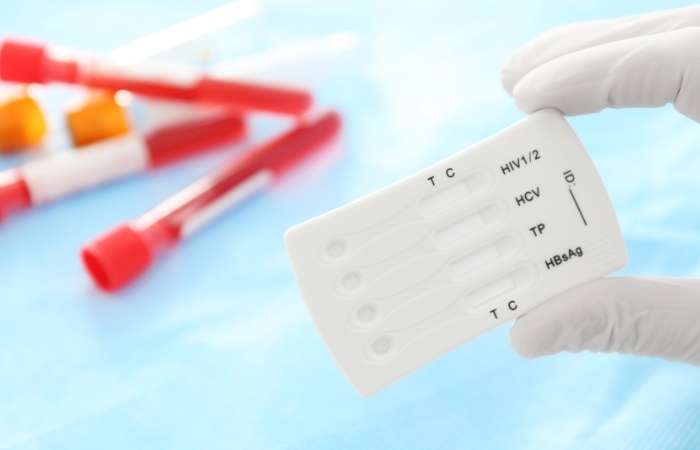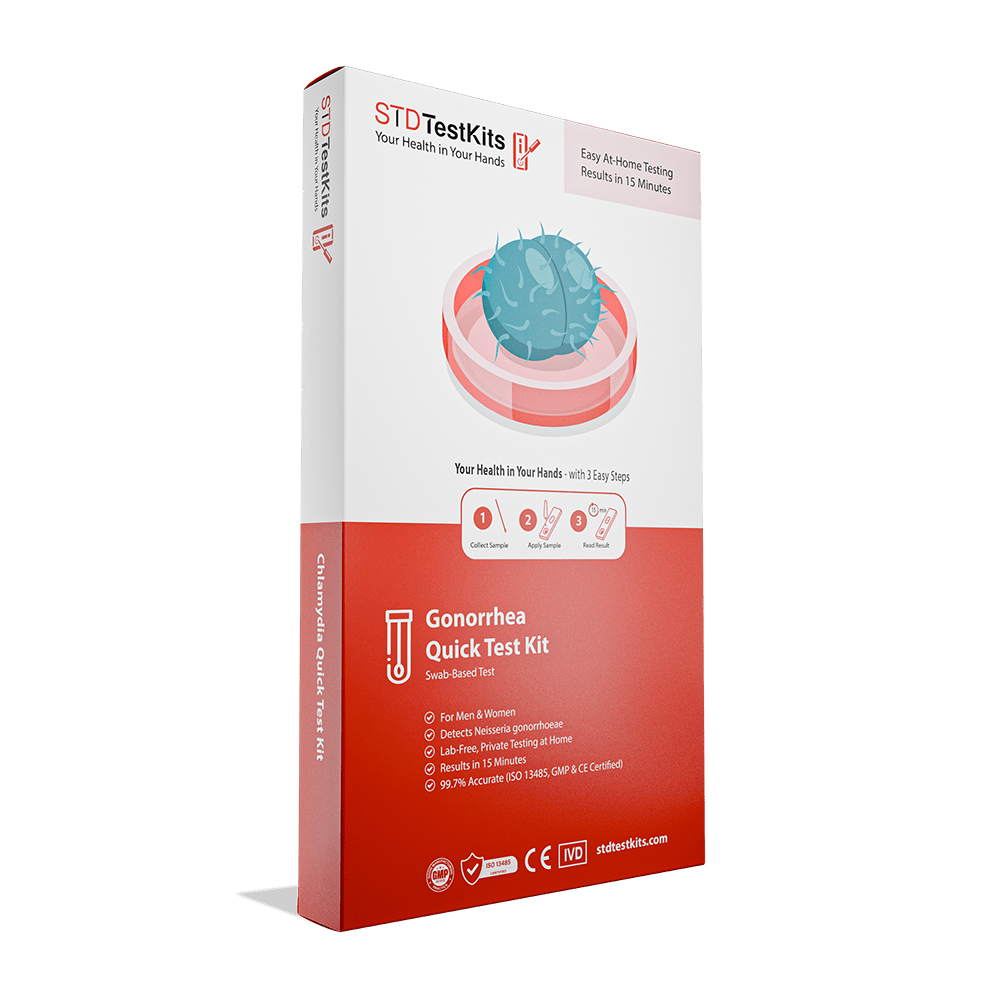Everything You’re Afraid to Ask About At-Home STD Tests
Quick Answer: Most at-home gonorrhea rapid tests are about 85–90% accurate when it comes to detecting infection, while lab-based NAAT tests score closer to 95–98%. That gap matters, but so do timing, technique, and how you read your results.
Why Accuracy Isn’t Just About Numbers
When people search “gonorrhea rapid test accuracy,” they’re not looking for a percentage, they’re looking for reassurance. They want to know if they can trust this kit enough to take a breath, to tell a partner, to move on with life. Accuracy has a human face. It’s the twenty-two-year-old who just had a condom break and can’t focus on class until the cassette gives an answer. It’s the single parent who doesn’t have time or money for a clinic visit and needs a clear result in the middle of the night. Accuracy isn’t just statistical, it’s emotional currency, the kind you spend every time you decide whether to believe a test line or not.
But numbers do matter. Because while a test can feel like a final verdict, the science reminds us it’s still a snapshot with limits. Understanding those limits is the key to avoiding false reassurance or unnecessary panic.

People are also reading: How Accurate Are Syphilis Rapid Tests in 2025?
Sensitivity vs. Specificity: The Two Sides of Accuracy
Behind every gonorrhea test, whether it’s a lab-based NAAT or a rapid cassette, is a balancing act between two qualities: sensitivity and specificity. Sensitivity asks, “If you have gonorrhea, how good is this test at catching it?” Specificity asks, “If you don’t have it, how good is this test at saying so?” Both matter. A test with high sensitivity will miss very few true cases. A test with high specificity will rarely cry wolf with false positives. But neither one hits 100% all the time.
Most at-home rapid tests are about 85–90% sensitive. That means that about one out of every ten infections can go undetected. This is often because the test was done too soon, the sample was not collected properly, or the bacteria levels were low at the time. On the other hand, specificity is higher, at 95% or more. That means there are fewer false positives, but they can still happen, especially if you read the test outside of the official time frame or if the kit has gotten worse while it was being stored. On the other hand, lab tests are more accurate because they look at bacterial DNA instead of surface proteins. However, this accuracy comes at the cost of time and ease of use.
Table 1: Comparing Test Accuracy
Figure 1. At-home gonorrhea tests give quick results with solid, but not perfect, accuracy. Lab NAAT tests remain the gold standard for sensitivity and specificity.
Accuracy Meets Real Life
Take Devon, for example. He tested at home five days after an unprotected hookup, anxious to get answers. The result came back negative, and for a moment the relief was like oxygen. But two weeks later, a burning sensation during urination reminded him something wasn’t right. A lab test confirmed gonorrhea. The issue wasn’t that the rapid test was worthless, it was that he tested too soon. Accuracy lives at the intersection of biology and timing. The kit can only reveal what’s detectable in the sample, and if the bacteria haven’t built up enough, even the best sensitivity won’t catch it.
This is why accuracy is never just a number in a manual. It’s a story that unfolds in real lives, with real stakes, where trust, mistakes, and biology collide.
Why False Negatives Are More Common
When people talk about test accuracy, what usually stings the most isn’t a false positive, it’s a false negative. A false positive may scare you for a few days, but a false negative can leave you carrying and spreading gonorrhea without knowing it. That’s why sensitivity is such a big deal. At-home gonorrhea rapid tests sometimes miss infections because the bacteria count isn’t high enough yet, because the swab or urine didn’t pick up enough cells, or because the kit wasn’t handled properly. None of that makes the test useless, it just means the result is only as strong as the context around it.
Consider Malik, who tested negative a week after a new relationship started. He and his partner stopped using condoms, reassured by the result. Three weeks later, she developed pelvic pain that sent her to urgent care. Both tested positive at the clinic. The mistake wasn’t trusting the test; it was trusting it as the whole truth without considering the timing. Gonorrhea doesn’t always show up right away, and that gap can trick even the most careful person.
False Positives: Rare, but Not Impossible
On the other side, false positives do happen, though far less often. With specificity rates in the 95–97% range, most rapid tests are very good at avoiding false alarms. But the chemistry isn’t flawless. Sometimes lines appear faintly because of evaporation after the official read window. Sometimes storage conditions, like heat or humidity, warp the chemicals inside. And sometimes it’s just user interpretation, mistaking a smudge or background line for the real thing. A false positive can shake trust in yourself or your partner, which is why confirmatory testing is so important before you react.
Jenna’s story illustrates this. She tested late at night, read the cassette under a dim lamp, and thought she saw a faint positive. The confrontation with her boyfriend was immediate and explosive. A day later, her clinic result came back negative. The kit hadn’t lied exactly, her eyes and the lighting had. That’s the kind of accuracy trap no statistic can warn you about, but one that plays out in bedrooms everywhere.
The Window Period Trap
Perhaps the biggest accuracy pitfall is the window period: the time between exposure and when the test can reliably detect infection. For gonorrhea, that’s usually around 7 to 14 days. Test before that, and your chances of a false negative shoot up. Many people test too soon because anxiety pushes them into action, but biology doesn’t care about your timeline. Until the bacteria multiply enough to trigger the test’s chemistry, the cassette may stay blank even though you’re already infected.
It’s like planting seeds and checking the soil the next morning. The plant is there, but it hasn’t sprouted enough to see yet. Testing is similar: accuracy grows with time, and rushing the process only leaves you guessing.
Table 2: Common Factors That Lower Gonorrhea Test Accuracy
Figure 2. The most common pitfalls that reduce gonorrhea rapid test accuracy, from timing mistakes to storage errors.
Human Mistakes Behind the Numbers
It’s easy to blame the test when results don’t add up, but often the culprit is human error. People test half-asleep, after drinking, or while distracted by their phones. They toss the instructions aside because they assume the steps are obvious. In reality, every missed detail, every extra drop of buffer, every second too early or late, can tip the outcome. And yet, those mistakes don’t mean you’ve failed. They mean you’re human. Accuracy isn’t just about chemistry; it’s about focus, environment, and patience, all of which can waver under stress.
That’s why retesting exists, not as punishment, but as protection. If your result doesn’t make sense, if it contradicts your symptoms, or if your gut says something isn’t right, the smartest move is to test again. Accuracy improves when you give yourself more than one chance to get it right.
Rapid Tests vs. Lab Tests: The Reliability Gap
The 90% vs 98% on paper doesn't sound very dramatic. But in real life, it means lost infections, broken trust, and sometimes long-term health complications. Lab-based NAAT tests, which diagnose gonorrhea by examining its genetic material, are the gold standard for a reason: they can pick up infections that rapid tests may miss, especially early on or with low bacterial burden. At-home rapid tests, meanwhile, are designed for expediency and discretion. They sacrifice sensitivity for the ability to have an answer in minutes.
But this gap doesn’t make one better and the other worse. They serve different purposes. The at-home test is your flashlight, shining quickly into the dark. The lab test is your floodlight, confirming the full picture with precision. Used together, they create a layered safety net, each covering where the other might fall short.

People are also reading: When to Test for Syphilis After Exposure (And When Not To)
Retesting: Accuracy Built Over Time
No test gives the whole story, regardless of its sophistication. Accuracy improves with retesting, as each result adds another information point. A test result as negative today might miss an infection that emerges a week from today. A test result as positive today is due for confirmation in ruling out false positives. Retesting isn't redundancy, it's planning. It anticipates that precision is dynamic, variable with time, setting, and biology.
Think of Ella, who tested negative at home two days after an exposure but couldn’t shake her anxiety. She tested again at day 12, and the line appeared. That second test gave her the clarity the first one couldn’t, because the infection had finally reached detectable levels. If she had stopped at the first test, she might have unknowingly spread gonorrhea to others. Retesting protected both her and her partners.
When to Trust vs. When to Retest
So how do you know if you can believe your test or if need be, re-check? The answer is time, symptom, and circumstance dependent. Tests taken with a negative result that fall within the two-week period of exposure hold more validity than tests taken prior to that time frame. Always re-check positive results, weak positives as well. Invalid results, tests without a control line, count for nothing. And if your body is screaming with symptoms that do not match your negative cassette, your body first.
Table 3: When to Trust vs. When to Retest
Figure 3. Scenarios showing when a gonorrhea rapid test result can be trusted and when it’s better to retest for accuracy and peace of mind.
The Human Side of Conflicting Results
Conflicting results can be some of the hardest to process. A negative home test one week, followed by a positive lab result the next, can leave you questioning your judgment, your body, even your relationships. That’s where the emotional weight of accuracy comes back into play. These tests aren’t just pieces of plastic, they’re verdicts you carry into conversations with partners, decisions about treatment, and sometimes life-changing choices about trust and intimacy.
Take Diego’s story. He tested positive at home and immediately told his partner, who reacted with anger and suspicion. A lab test days later came back negative. For weeks, their relationship was strained under the shadow of a false alarm. Diego wasn’t wrong to test, and he wasn’t wrong to trust the kit in that moment. But the gap between the rapid test and the lab result created real-world fallout that numbers on a chart can’t capture. Accuracy isn’t just science, it’s lived experience, and that’s why retesting and confirmation are so critical.
FAQs
1. Are gonorrhea rapid tests really reliable?
They’re reliable enough to matter, but not magic. Most catch about 9 out of 10 infections when used correctly. That’s huge compared to guessing or ignoring it. Still, if you want near-perfect clarity, a lab test will always have the edge.
2. What if my test shows a faint line?
Imagine you’re in the bathroom at midnight, squinting under a weak light, and there’s the faintest shadow of a line. You want to believe it’s nothing, but here’s the truth: a line is a line. Faint still means positive. Don’t let denial talk you into ignoring it. Retest or head to a clinic, you’ll thank yourself later.
3. Can I test right after unprotected sex?
You can, but the result won’t mean much. Gonorrhea needs time to grow enough for a test to spot it. Testing the same day is like opening the oven after two minutes and wondering why the cake is still batter. Give it at least a week, two is even better, if you want results you can actually trust.
4. Why would my test say negative if I feel symptoms?
Timing is often the villain. If you tested too soon, the bacteria may not have multiplied enough yet. Or maybe the swab didn’t hit the right spot. Either way, your body doesn’t lie. If you’re burning when you pee or notice unusual discharge, believe your body first and the cassette second. Retest or book a lab test right away.
5. Do false positives happen?
Rarely, but yes. Most kits are very specific, which means they’re good at avoiding false alarms. But sometimes you’ll misread an evaporation line, or a kit stored in bad conditions might glitch. If you get a result that doesn’t match your reality, confirm it before blowing up your relationship or spiraling into panic.
6. Should I test again after treatment?
Absolutely. Reinfection is sneaky. Maybe your partner didn’t finish their meds, or you hooked up again too soon. That’s why health providers usually recommend retesting after three months. It’s not paranoia, it’s just smart maintenance, like checking your tire pressure before a road trip.
7. Is a urine test enough?
Sometimes, yes, but not always. Urine catches genital gonorrhea, but it won’t see what’s hiding in your throat or rectum. If oral or anal sex is part of your history, swabs are the only way to know for sure. Many people walk around with throat gonorrhea and don’t even know it until a partner gets symptoms.
8. Can I use an expired kit if it looks okay?
You could, but it’s like drinking milk a week past the date, it might taste fine, but you can’t really trust it. Expired kits lose chemical strength, which means results get fuzzy. Save yourself the doubt and use one that’s still in date.
9. How private are at-home STD Test Kits?
About as private as it gets. The package doesn’t scream what’s inside, and no one but you ever sees the results. No awkward clinic waiting rooms, no explaining yourself to strangers, just you and the answers, in your own space.
10. What if I panic while waiting for the result?
You’re not the only one. Ten minutes with a cassette can feel longer than an international flight. The trick? Set a timer, walk away, blast a song, scroll your feed, do anything but stare. When the timer buzzes, the answer will be waiting. Whatever shows up, you’ll deal with it, because you’ve already proven you care enough to check.
Taking Back Control
Accuracy isn’t just a number on a chart, it’s the difference between fear and clarity, between silence and action. Gonorrhea rapid tests aren’t flawless, but they’re powerful tools. They give you answers tonight, not next week. They let you test in private, on your own terms. And when you respect the timing, follow the instructions, and retest when needed, their accuracy becomes reliable enough to trust.
If you’re ready to take control of your health, discreet STD Test Kits are available to test for gonorrhea and other common infections. Privacy doesn’t have to mean compromise, you can get both speed and confidence, right in your own space.
How We Sourced This Article: This piece was built from about fifteen sources, blending public health guidance, peer-reviewed science, and real-world stories. We highlighted six of the most reader-friendly and trustworthy references below to back up the science and practical advice shared here.
Sources
1. CDC – STD Treatment Guidelines: Gonorrhea
2. WHO – Sexually Transmitted Infections Fact Sheet
3. Diagnostic accuracy of a prototype rapid chlamydia and gonorrhoea assay | PMC
4. Point-of-care assays & gonorrhea: development, evaluation, and challenges | PMC
5. Advantages & Accuracy of Rapid STI Tests (Gonorrhea section) | Verywell Health
6. Gonorrhea: When You Do and Don’t Know You Have It | Verywell Health
About the Author
Dr. F. David, MD is a board-certified infectious disease specialist who has spent his career focusing on STI prevention and sexual health equity. His writing blends medical accuracy with a trauma-informed, sex-positive voice that connects with real people navigating real fears.
Reviewed by: C. Alvarez, PA-C | Last medically reviewed: October 2025
This article is for informational purposes only and does not replace professional medical advice.






